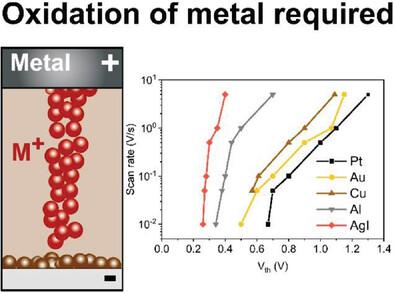当前位置:
X-MOL 学术
›
Adv. Funct. Mater.
›
论文详情
Our official English website, www.x-mol.net, welcomes your
feedback! (Note: you will need to create a separate account there.)
Role of Metal Contacts on Halide Perovskite Memristors
Advanced Functional Materials ( IF 18.5 ) Pub Date : 2023-07-14 , DOI: 10.1002/adfm.202305211 José Carlos Pérez‐Martínez 1, 2 , Mariana Berruet 1, 3 , Cedric Gonzales 1 , Saeed Salehpour 1, 4 , Ali Bahari 4 , Belén Arredondo 3 , Antonio Guerrero 1
Advanced Functional Materials ( IF 18.5 ) Pub Date : 2023-07-14 , DOI: 10.1002/adfm.202305211 José Carlos Pérez‐Martínez 1, 2 , Mariana Berruet 1, 3 , Cedric Gonzales 1 , Saeed Salehpour 1, 4 , Ali Bahari 4 , Belén Arredondo 3 , Antonio Guerrero 1
Affiliation

|
Halide perovskites are promising candidates for resistive memories (memristors) due to their mixed electronic/ionic conductivity and the real activation mechanism is currently under debate. In order to unveil the role of the metal contact and its connection with the activation process, four model systems are screened on halide perovskite memristors: Nearly inert metals (Au and Pt), low reactivity contacts (Cu), highly reactive contact (Ag and Al), and pre-oxidized metal in the form of AgI. It is revealed that the threshold voltage for activation of the memory effect is highly connected with the electrochemical activity of the metals. Redox/capacitive peaks are observed for reactive metals at positive potentials and charged ions are formed that can follow the electrical field. Activation proceeds by formation of conductive filaments, either by the direct migration of the charged metals or by an increase in the concentration of halide vacancies generated by this electrochemical reaction. Importantly, the use of pre-oxidized Ag+ ions leads to very low threshold voltages of ≈0.2 V indicating that an additional electrochemical reaction is not needed in this system to activate the memristor. Overall, the effect of the metal contact is clarified, and it is revealed that AgI is a very promising interfacial layer for low-energy applications.
中文翻译:

金属触点对卤化物钙钛矿忆阻器的作用
卤化物钙钛矿由于其混合的电子/离子导电性而成为阻变存储器(忆阻器)的有前途的候选者,并且真正的激活机制目前仍在争论中。为了揭示金属接触的作用及其与激活过程的联系,在卤化物钙钛矿忆阻器上筛选了四种模型系统:近惰性金属(Au和Pt)、低反应性接触(Cu)、高反应性接触(Ag和Pt)。 Al) 和 AgI 形式的预氧化金属。研究表明,记忆效应激活的阈值电压与金属的电化学活性密切相关。在正电势下观察到活性金属的氧化还原/电容峰,并形成可以跟随电场的带电离子。通过带电金属的直接迁移或通过增加由该电化学反应产生的卤化物空位的浓度,形成导电丝来进行活化。重要的是,使用预氧化的 Ag +离子会产生非常低的阈值电压(约 0.2 V),这表明该系统中不需要额外的电化学反应来激活忆阻器。总体而言,金属接触的影响得到了阐明,并且表明 AgI 是一种非常有前途的低能应用界面层。
更新日期:2023-07-14
中文翻译:

金属触点对卤化物钙钛矿忆阻器的作用
卤化物钙钛矿由于其混合的电子/离子导电性而成为阻变存储器(忆阻器)的有前途的候选者,并且真正的激活机制目前仍在争论中。为了揭示金属接触的作用及其与激活过程的联系,在卤化物钙钛矿忆阻器上筛选了四种模型系统:近惰性金属(Au和Pt)、低反应性接触(Cu)、高反应性接触(Ag和Pt)。 Al) 和 AgI 形式的预氧化金属。研究表明,记忆效应激活的阈值电压与金属的电化学活性密切相关。在正电势下观察到活性金属的氧化还原/电容峰,并形成可以跟随电场的带电离子。通过带电金属的直接迁移或通过增加由该电化学反应产生的卤化物空位的浓度,形成导电丝来进行活化。重要的是,使用预氧化的 Ag +离子会产生非常低的阈值电压(约 0.2 V),这表明该系统中不需要额外的电化学反应来激活忆阻器。总体而言,金属接触的影响得到了阐明,并且表明 AgI 是一种非常有前途的低能应用界面层。































 京公网安备 11010802027423号
京公网安备 11010802027423号